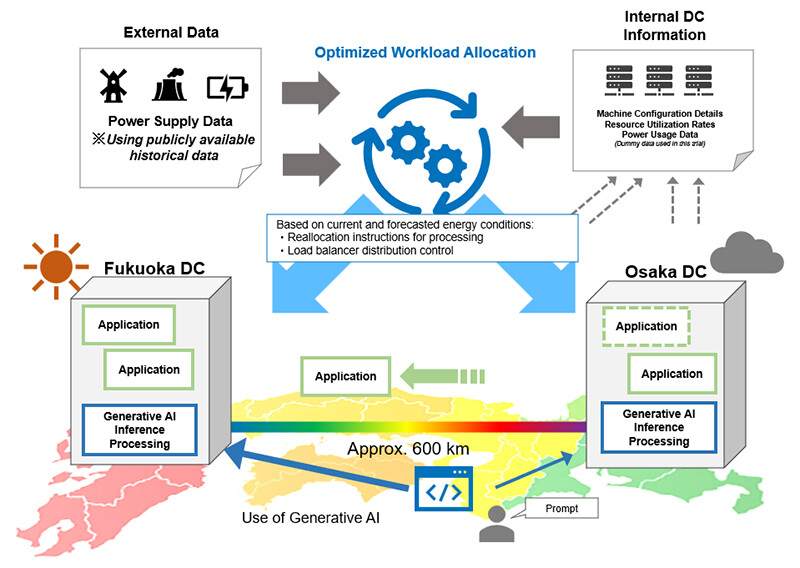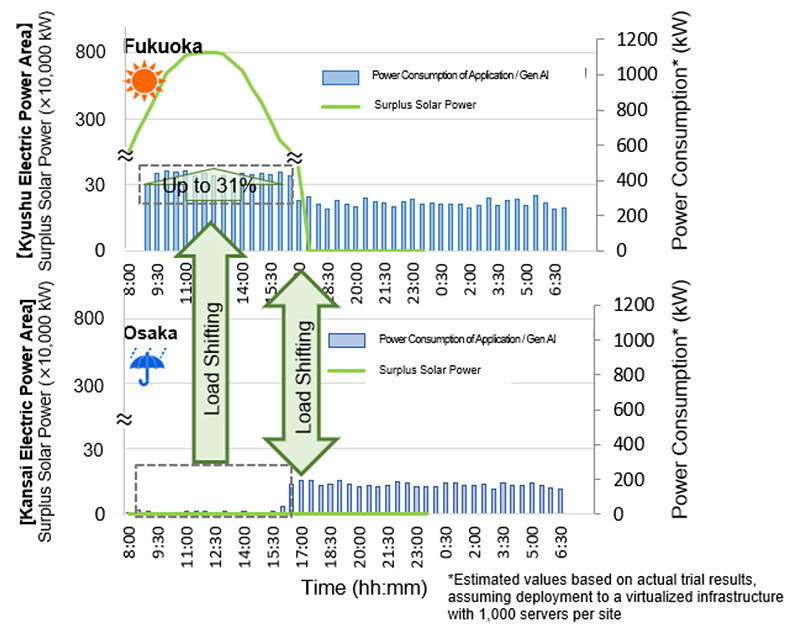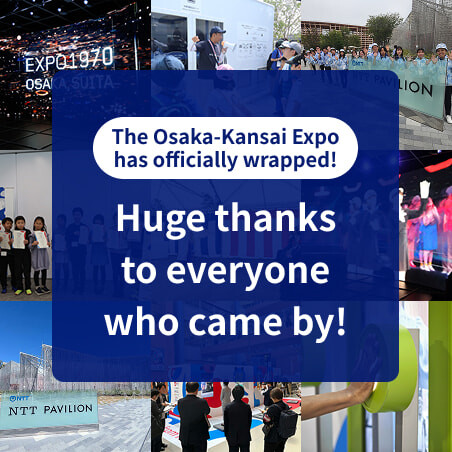Microsoft ends support for Internet Explorer on June 16, 2022.
We recommend using one of the browsers listed below.
- Microsoft Edge(Latest version)
- Mozilla Firefox(Latest version)
- Google Chrome(Latest version)
- Apple Safari(Latest version)
Please contact your browser provider for download and installation instructions.
June 11, 2025
NTT WEST Corporation
NTT Corporation
QTnet, Inc.
Successful Demonstration of Optimized Workload Allocation Between Remote Data Centers Using IOWN APN
- Contributing to carbon neutrality through the proactive use of renewable energy -
News Highlights:
- Demonstrated workload optimization based on regional power conditions in a real-world environment connecting long-distance data centers in Fukuoka and Osaka via IOWN APN
- Verified the effectiveness of live application migration and generative AI inference processing in increasing the utilization of renewable energy
TOKYO - June 11, 2025 - NTT WEST Corporation (Headquarters: Miyakojima, Osaka; President and CEO: Ryota Kitamura; hereinafter "NTT WEST"), NTT Corporation (Headquarters: Chiyoda, Tokyo; President and CEO: Akira Shimada; hereinafter "NTT"), and QTnet, Inc. (Headquarters: Fukuoka, Fukuoka Prefecture, President: Yoshio Ogura, hereinafter "QTnet") have jointly demonstrated that even in a computing environment where data centers (DCs) are geographically dispersed, it is possible to optimize workload placement by leveraging the high-capacity, low-latency communication features of IOWN APN1 (All-Photonics Network). This dynamic optimization adjusts processing distribution based on computing load and power consumption.
This achievement shows that by reallocating workloads to DCs located in regions with a surplus of renewable energy, it is possible to proactively utilize such energy sources and thereby contribute to carbon neutrality.
Going forward, the three companies will continue to advance technology development toward the full-scale implementation and service application of the technologies used in this demonstration, with the aim of enhancing DC value and reducing environmental impact through the use of IOWN APN technologies.
Background
As demand for AI, IoT, and other digital technologies continues to grow, DCs are becoming increasingly critical. From the perspectives of disaster resilience and energy efficiency, expectations are rising for the effective use of geographically distributed DCs.
However, despite the expansion of renewable energy, approximately 1.9 billion kWh of electricity is curtailed annually across Japan to maintain the supply-demand balance2, meaning that a significant amount of generated renewable energy remains underutilized.
To address this challenge, NTT WEST and NTT have been leveraging IOWN APN—a high-capacity, low-latency communication infrastructure—to connect distributed DCs and accumulate technological expertise and practical use cases for utilizing renewable energy across multiple sites.
QTnet, for its part, provides DC services in Fukuoka, a region with low disaster risk, and offers ICT services through an extensive fiber-optic network throughout Kyushu. QTnet also operates DCs powered by renewable energy and actively promotes environmentally conscious initiatives and business development.
In this joint initiative, the three companies conducted an experimental demonstration of distributed DC construction using IOWN APN, focusing on optimizing workload placement in response to renewable energy availability.
Demonstration Overview
To validate the execution of workload optimization, a distributed DC environment was constructed using IOWN APN to connect DCs located in Fukuoka and Osaka—approximately 600 kilometers apart. This environment consisted of a virtualized infrastructure hosting applications and a generative AI platform. Traditionally, long-distance live migration—relocating applications without service interruption—has posed challenges due to downtime impacting applications. However, by utilizing IOWN APN, we were able to build a distributed DC environment that minimizes increases in downtime.
Next, to assess the effectiveness of workload optimization in improving renewable energy utilization, we conducted an experiment using actual data from a day when output curtailment of renewable energy occurred in the Kyushu region. Based on the amount of renewable energy generated and the power consumption of each DC, the system dynamically selected which DC would handle the processing workload at 30-minute intervals (Figure 1).
 Figure 1 Overall Concept of Autonomous Control Experiment Based on Renewable Energy Supply and Demand
Figure 1 Overall Concept of Autonomous Control Experiment Based on Renewable Energy Supply and Demand
As a result of the experiment, the proposed workload optimization approach demonstrated an improvement of up to 31% in renewable energy utilization at the targeted DC, compared to a method that distributes workloads uniformly. This figure is based on estimations derived from the experimental environment (Figure 2).
 Figure 2 Power Transition with System Implementation
Figure 2 Power Transition with System Implementation
Calculating the workload optimization plan required intensive computation, as it needed to account for a wide range of factors—including external power supply-demand conditions and internal resource statuses at each DC. However, in this demonstration, by leveraging NTT's proprietary algorithm, we successfully generated a full day's optimization plan in under two minutes.
This result indicates the potential scalability of the approach for larger environments.
Moreover, this method is applicable to environments connecting three or more DCs. By concentrating workloads in regions with surplus power supply, the system can promote more effective use of renewable energy and further contribute to carbon neutrality.
Roles of Each Company
Future Developments
The results of this demonstration highlight the potential to actively promote the use of renewable energy in response to growing demand for DCs, while also reducing their environmental impact. Going forward, we will continue to develop technologies and validate use cases that support both the expansion of DC utilization for AI, IoT, and other emerging needs, and the achievement of sustainability goals.
As demonstrated in this trial, IOWN APN has the potential to generate new value not only through its networking capabilities, but also through integration with control and computing functions. The participating companies will continue to collaborate on further experiments to maximize the value of IOWN APN and work toward solving regional and societal challenges.
[Glossary]
1IOWN APN (All-Photonics Network)
IOWN consists primarily of three elements: the All-Photonic Network (APN), which extends photonics beyond the network into terminal processing; Digital Twin Computing, which enables advanced and real-time interaction between people and objects in cyberspace; and the Cognitive Foundation, which efficiently allocates various ICT resources, including these technologies.
APN introduces innovative photonic technologies into everything from networks to terminals and even within chips, making possible ultra-low power consumption and ultra-high-speed processing that were previously difficult to achieve. By assigning a different wavelength to each function over a single optical fiber, APN can deliver multiple essential services—such as data communications like the Internet and sensing functions—simultaneously and without mutual interference, thereby supporting the foundations of social infrastructure.
https://www.rd.ntt/e/iown/
2Source: From the materials of the 52nd meeting of the Subcommittee on Energy Conservation and New Energy / Electricity and Gas Basic Policy Subcommittee, System Working Group, under the Agency for Natural Resources and Energy, Ministry of Economy, Trade and Industry (METI), Japan.
https://www.meti.go.jp/shingikai/enecho/shoene_shinene/shin_energy/keito_wg/pdf/052_01_00.pdf (Japanese)
About NTT
NTT contributes to a sustainable society through the power of innovation. We are a leading global technology company providing services to consumers and businesses as a mobile operator, infrastructure, networks, applications, and consulting provider. Our offerings include digital business consulting, managed application services, workplace and cloud solutions, data center and edge computing, all supported by our deep global industry expertise. We are over $90B in revenue and 340,000 employees, with $3B in annual R&D investments. Our operations span across 80+ countries and regions, allowing us to serve clients in over 190 of them. We serve over 75% of Fortune Global 100 companies, thousands of other enterprise and government clients and millions of consumers.
Media contacts
NTT WEST Corporation
Public Relations
06-6490-0024
nttw-press@west.ntt.co.jp
NTT Information Network Laboratory Group
Public Relations
Inquiry Form
QTnet, Inc.
Advertising and PR Department
092-981-7773
qt_press@qtnet.co.jp
Information is current as of the date of issue of the individual press release.
Please be advised that information may be outdated after that point.
NTT STORY
WEB media that thinks about the future with NTT










